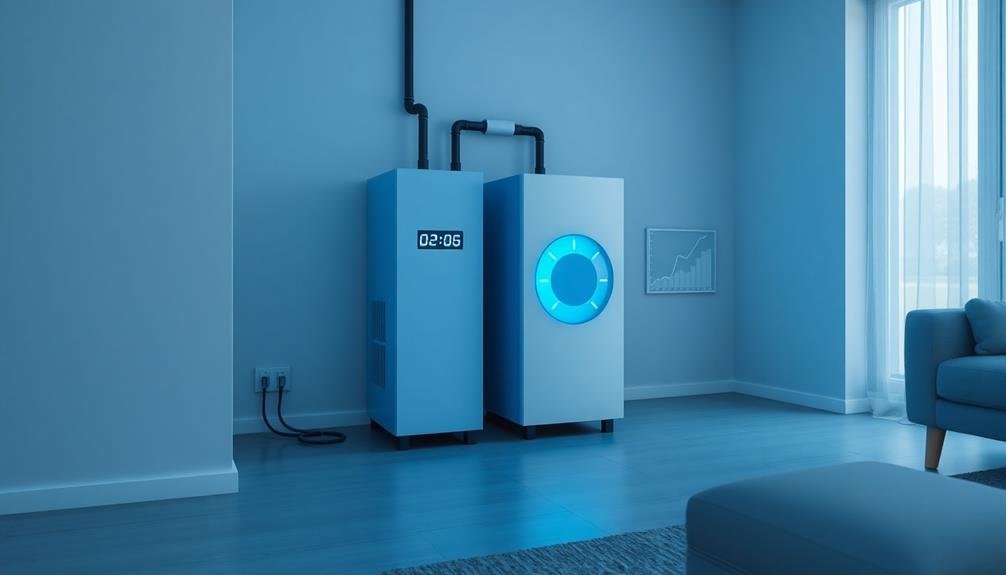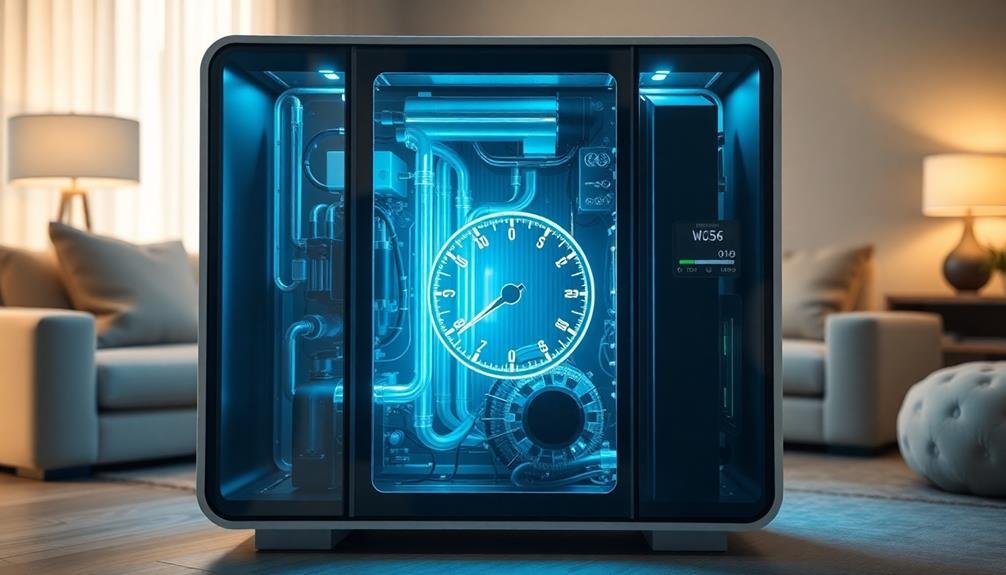To maximize your home's energy efficiency with fuel cells, you'll need to understand seven key ratings. These include electrical efficiency, combined heat and power efficiency, and fuel utilization efficiency, which measure how effectively the system converts fuel into usable energy. Startup time and performance, load following capability, and durability ratings indicate how well the system operates over time. Finally, the environmental impact score helps you assess the ecological footprint. By considering these ratings, you'll make an informed decision about the best fuel cell system for your home. Diving deeper into each rating will reveal how they can benefit your specific energy needs.
Electrical Efficiency Rating

Electrical efficiency is a crucial factor when evaluating home fuel cell systems. It measures how effectively the fuel cell converts its input fuel into usable electricity. You'll typically see this rating expressed as a percentage, with higher numbers indicating better performance.
To calculate electrical efficiency, manufacturers divide the electrical energy output by the total energy content of the fuel input. For example, if a fuel cell system produces 5 kWh of electricity from 10 kWh worth of natural gas, its electrical efficiency would be 50%.
Most residential fuel cells achieve electrical efficiencies between 35% and 60%. However, these numbers can vary based on factors like fuel type, operating temperature, and system design.
You'll want to pay attention to both peak and average efficiency ratings, as performance may fluctuate under different load conditions.
When comparing fuel cell systems, remember that electrical efficiency isn't the only consideration. Overall system efficiency, which includes usable heat production, is often higher.
You should also factor in fuel costs, maintenance requirements, and environmental impact to make an informed decision about the best fuel cell system for your home.
Combined Heat and Power Efficiency
Combined Heat and Power (CHP) efficiency takes into account both the electrical output and the usable heat produced by a fuel cell system. This measure provides a more thorough view of a fuel cell's overall efficiency, as it considers the total energy utilized from the fuel source.
To calculate CHP efficiency, you'll add the electrical efficiency to the thermal efficiency. For example, if a fuel cell has an electrical efficiency of 40% and can capture 40% of the heat for useful purposes, its CHP efficiency would be 80%.
CHP efficiency is particularly important for home fuel cells because it reflects the system's ability to provide both electricity and heat for your household needs. Many residential fuel cell systems are designed to capture waste heat for space heating, water heating, or other applications.
You'll often see CHP efficiencies ranging from 80% to 95% for modern home fuel cell systems. These high efficiencies make fuel cells an attractive option for homeowners looking to maximize energy utilization and reduce overall energy costs.
When comparing fuel cell systems, pay close attention to the CHP efficiency rating to make sure you're getting the most value from your investment.
Fuel Utilization Efficiency

Another essential metric to take into account when evaluating home fuel cells is fuel utilization efficiency. This measure indicates how effectively a fuel cell converts its fuel input into electrical energy. It's calculated by dividing the electrical power output by the energy content of the fuel consumed.
You'll typically see fuel utilization efficiency expressed as a percentage, with higher values indicating better performance. Modern home fuel cells can achieve fuel utilization efficiencies of 45-60%, which is notably higher than traditional power generation methods.
When you're comparing fuel cells, pay attention to their fuel utilization efficiency ratings. A higher rating means you'll get more electricity from the same amount of fuel, potentially lowering your operating costs.
However, don't forget to take into account other factors like initial cost, maintenance requirements, and overall system efficiency.
It's worth noting that fuel utilization efficiency doesn't account for heat recovery. For a more thorough understanding of a fuel cell's performance, you should also look at its combined heat and power efficiency. This metric considers both electrical output and recovered heat, giving you a fuller picture of the system's overall efficiency.
Startup Time and Performance
Startup time and performance are essential factors to take into account when evaluating home fuel cells. When you're considering a fuel cell system for your home, you'll want to understand how quickly it can begin producing electricity and how well it maintains its performance over time.
Startup time refers to how long it takes for the fuel cell to reach its ideal operating temperature and start generating power. This can range from a few minutes to several hours, depending on the type of fuel cell. Solid oxide fuel cells (SOFCs) typically have longer startup times due to their high operating temperatures, while proton exchange membrane (PEM) fuel cells can start up more quickly.
Performance relates to the fuel cell's ability to maintain consistent power output and efficiency over its lifespan. You'll want to look for systems that offer stable performance under various load conditions and minimal degradation over time.
Some key performance indicators include power density, voltage stability, and durability. High-quality fuel cells should maintain their efficiency for thousands of operating hours, with minimal loss in performance.
Regular maintenance and proper operation can help guarantee ideal long-term performance of your home fuel cell system.
Load Following Capability

Load following capability is a key feature of home fuel cell systems that directly impacts their efficiency and usefulness. It refers to the system's ability to adjust its power output in response to changing energy demands in your home. The better a fuel cell can follow your home's load, the more efficient it'll be overall.
When you're evaluating home fuel cell systems, you'll want to look for units with high load following capability. These systems can quickly ramp up or down their power production to match your needs, whether you're running multiple appliances or just charging your phone. This flexibility helps minimize wasted energy and reduces the need for supplementary power sources.
Some fuel cells can operate efficiently at partial loads, maintaining high efficiency even when demand is low. Others may struggle at lower outputs, leading to decreased efficiency.
You should also consider the system's turndown ratio, which indicates the range between its maximum and minimum power output. A higher turndown ratio generally means better load following capability and increased overall efficiency in real-world use.
Durability and Lifespan Rating
When evaluating home fuel cells, you'll want to contemplate their durability and lifespan rating.
You should assess the longevity of the fuel cell system, including its expected operational life and any maintenance requirements.
It's essential to examine how the fuel cell's performance may change over time, as this can impact its long-term efficiency and cost-effectiveness.
Longevity of Fuel Cells
Fuel cells consistently demonstrate impressive longevity, making them an attractive option for long-term home energy solutions. You'll find that most residential fuel cells can operate continuously for 40,000 to 80,000 hours, which translates to about 5 to 10 years of uninterrupted service. This extended lifespan is due to their solid-state design, which minimizes moving parts and reduces wear and tear.
To maximize your fuel cell's longevity, you'll need to perform regular maintenance. This includes replacing filters, checking connections, and monitoring performance metrics. Some manufacturers offer remote monitoring services, allowing you to track your system's health in real-time.
The longevity of fuel cells can vary based on factors such as usage patterns, environmental conditions, and fuel quality. You'll get the best results by following the manufacturer's guidelines and using high-quality fuel sources.
It's worth noting that while the fuel cell stack itself has a long lifespan, peripheral components like pumps and blowers may need replacement sooner. When evaluating fuel cell systems, consider the warranty coverage and availability of replacement parts to guarantee you're making a sound long-term investment.
Maintenance Requirements Assessment
Evaluating the maintenance requirements of home fuel cells is essential for understanding their durability and lifespan. When appraising a fuel cell's maintenance needs, you'll want to take into account factors such as the frequency of inspections, component replacements, and system cleanings.
Most home fuel cells require periodic inspections, typically every 3-6 months, to guarantee peak performance. During these checks, you'll need to examine the fuel cell stack, electrical connections, and cooling systems for any signs of wear or damage. You may also need to replace air filters and perform software updates.
The fuel cell stack itself is the heart of the system and generally has a lifespan of 5-10 years. You'll need to factor in the cost and effort of replacing this component when evaluating long-term maintenance.
Additionally, water treatment systems, used to purify water for the fuel cell's operation, may require regular filter changes and occasional descaling.
To accurately evaluate a fuel cell's maintenance requirements, take into account the manufacturer's recommended service schedule, the availability of replacement parts, and the level of technical expertise needed for upkeep. This information will help you determine the overall durability and lifespan rating of the home fuel cell system.
Performance Over Time
The performance of home fuel cells over time is a critical factor in determining their overall value and efficiency. As you evaluate different models, you'll want to take into account their durability and lifespan ratings. These metrics indicate how well the fuel cell maintains its efficiency and output capacity over extended periods.
Most residential fuel cells are designed to last between 10 to 15 years, but their performance may gradually decline during this time. You'll need to look at the degradation rate, which measures the annual decrease in power output. A lower degradation rate means better long-term performance. Top-rated models typically have degradation rates of less than 1% per year.
It's also important to take into account the fuel cell's ability to withstand repeated start-stop cycles and varying load demands. High-quality units will maintain consistent performance despite these fluctuations.
Additionally, check for warranties and manufacturer support, as these can provide insight into the expected longevity of the system. By carefully evaluating these factors, you'll be better equipped to choose a home fuel cell that offers reliable, efficient performance throughout its lifespan.
Environmental Impact Score

An often overlooked aspect of home fuel cell systems is their environmental impact score. This metric measures the overall ecological footprint of a fuel cell throughout its lifecycle, from production to disposal. You'll find that manufacturers are increasingly providing this score to help you make informed decisions about your home energy solutions.
The environmental impact score typically regards factors such as carbon emissions, water usage, and resource consumption. It's calculated by evaluating the fuel cell's manufacturing process, operational efficiency, and end-of-life recyclability. A lower score indicates a more environmentally friendly system.
When analyzing fuel cells, you should compare their scores to those of traditional energy sources. You'll often discover that fuel cells have notably lower environmental impacts, especially when using renewable hydrogen sources. However, it's essential to take into account the full picture, including the environmental costs of hydrogen production and transportation.
Some manufacturers go beyond the basic score, offering detailed breakdowns of their systems' impacts on air quality, water resources, and land use. You can use this information to align your choice with your specific environmental priorities and local ecosystem considerations.
Frequently Asked Questions
How Do Fuel Cell Costs Compare to Traditional Home Energy Systems?
You'll find fuel cells are typically more expensive upfront than traditional systems. However, they can save you money long-term through lower operating costs and higher efficiency. It's important to evaluate both initial and ongoing expenses when comparing options.
Can Home Fuel Cells Be Used Off-Grid or in Remote Locations?
Yes, you can use home fuel cells off-grid or in remote locations. They're ideal for areas without access to power lines. You'll need a fuel source like natural gas or propane, but they'll provide reliable electricity independently.
What Maintenance Is Required for Residential Fuel Cell Systems?
You'll need to perform regular maintenance on your residential fuel cell system. This includes replacing filters, checking for leaks, and scheduling annual inspections. You should also monitor performance and clean components as needed. Don't forget to replenish fuel supplies regularly.
Are There Government Incentives Available for Installing Home Fuel Cells?
Yes, you'll find government incentives for home fuel cells. They often include federal tax credits, state rebates, and local grants. You should check with your state's energy office and utility companies for specific programs available in your area.
How Noisy Are Fuel Cell Systems Compared to Other Home Energy Technologies?
You'll find fuel cell systems are relatively quiet. They're often compared to refrigerators in noise level. They're typically quieter than gas generators and some HVAC systems, but slightly louder than solar panels, which are silent.
In Summary
You've now got a solid grasp of the key efficiency ratings for home fuel cells. Remember, it's not just about electrical efficiency—consider the combined heat and power, fuel utilization, and load following capabilities too. Don't forget to factor in startup time, durability, and environmental impact when making your decision. By understanding these ratings, you'll be well-equipped to choose the most efficient and suitable fuel cell system for your home.





Leave a Reply